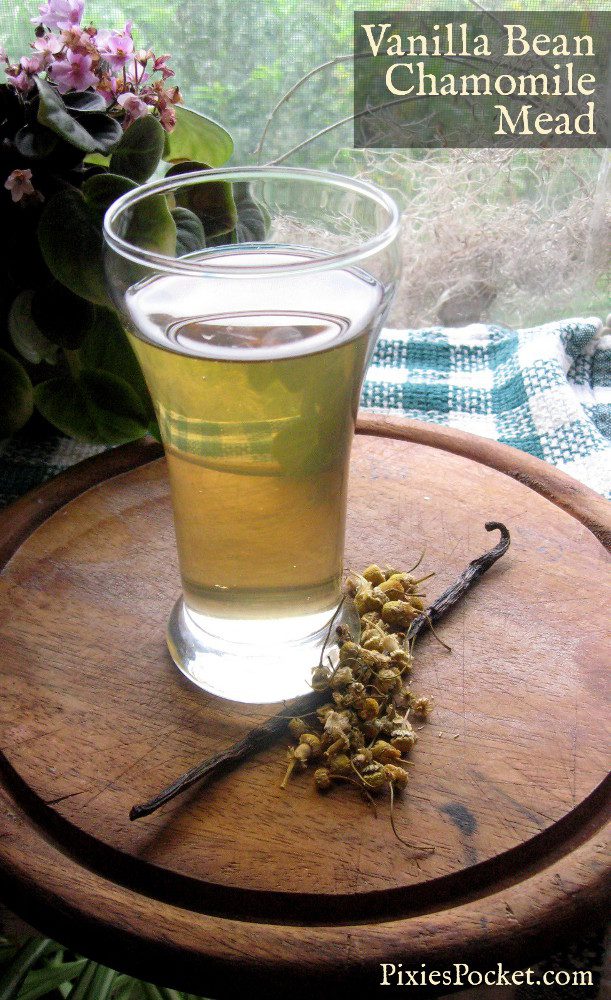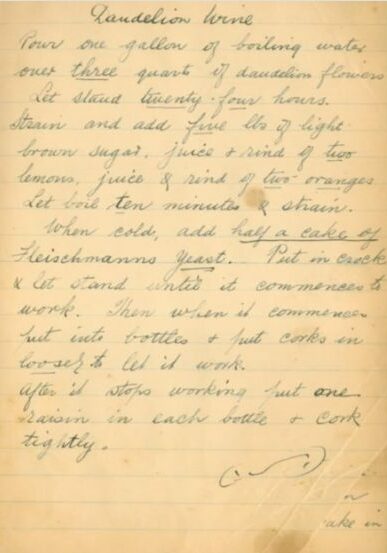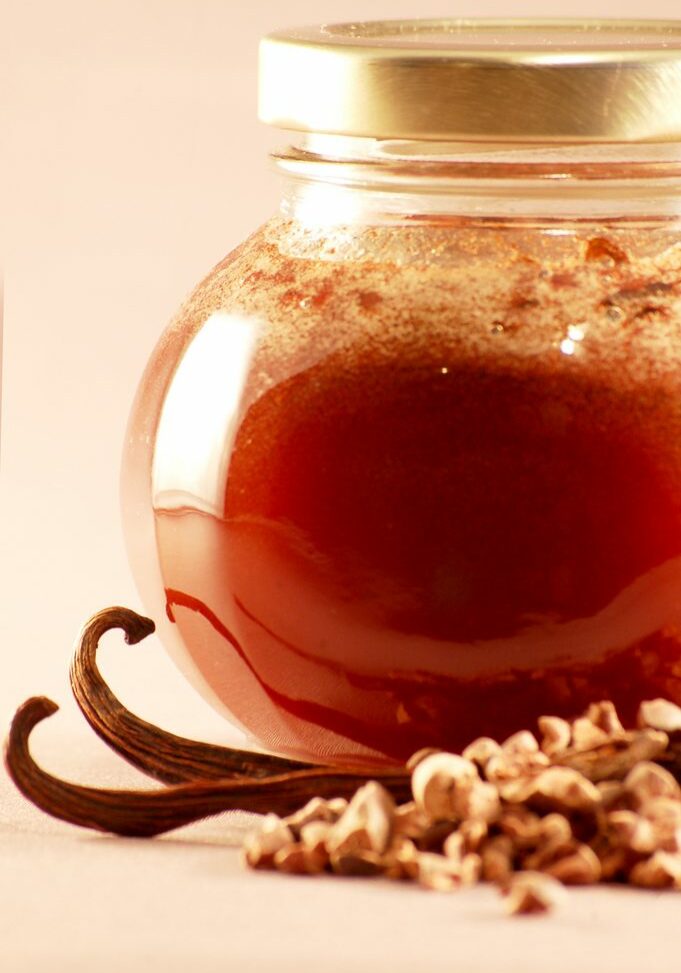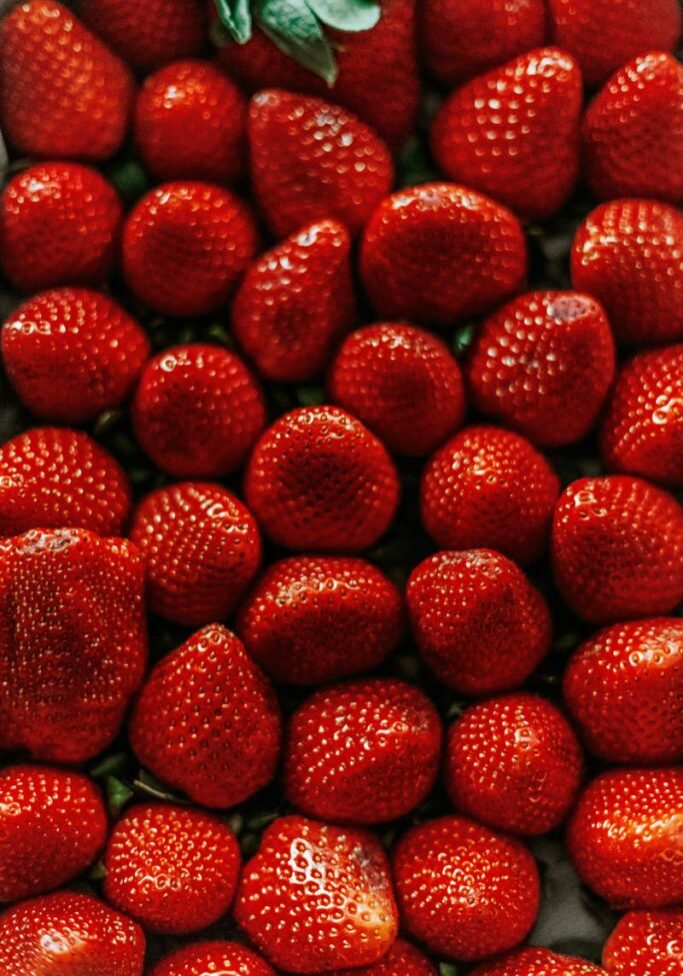Blog, Booze Recipes, Fermentation Recipes, Fermented Food, Herbal Recipes, Homebrew Recipes, Recipe Box
Vanilla Bean Chamomile Mead – One Gallon Recipe
Amber Shehan • March 7, 2015
Vanilla bean blends with chamomile beautifully - the bitter apple tones of chamomile flowers make magic with the rich, luscious aromatics of real vanilla.

When I began making infused honey, the first and favorite of my herbal honey blends was Vanilla Bean Chamomile Honey. It was only natural that I tried using infused honey to make a small batch of mead. I’m so glad that I experimented – this rich and heart-lifting mead remains one of my most successful brews, remade as often as I can afford the vanilla beans.
This recipe assumes that you have basic brewing knowledge and equipment at hand. Need some tips to help get you started? Check out my page for brewing one-gallon batches of wine and mead here or grab a copy of my book:

Vanilla Bean Chamomile Mead
This recipe is for a one-gallon batch of semi-sweet to dry mead. If you want to see more weird brews, check out my brewing page and grab a copy of Artisanal Small-Batch Brewing.
Ingredients
- 1 gallon of water (filtered is best, or anything non-chlorinated)
- 3-4 lbs local honey (about 4 cups)
- One heaping handful of dried Chamomile Flowers (about 1/2 cup)
- One handful of chopped raisins (about 1/2 cup)
- One Vanilla Bean, split
- 1/2 packet of yeast (champagne yeast for dry, sweet wine or mead yeast for a sweeter result or a pinch or two of bread yeast will work)
Procedure
Grab a large stockpot and add about 2/3 of a gallon of water. Allow it to come to a boil.
While the water is heating, use the time to sanitize your gallon carboy, airlocks, bungs, and funnel. Make sure you rinse everything well with clean water before using it.
When the water is at a steady, rolling boil, remove it from heat. Add in the raisins and chamomile and give it a stir. Cover the pot and let it sit for about fifteen minutes.
Uncover the pot, pour in the honey, and stir it until it is all mixed. Think happy thoughts and enjoy the scent! I love honey sauna time.
Using a funnel, pour the wort (flowers and all) into the sanitized gallon jug. Split the vanilla bean and drop it into the jug.
Pour in the rest of the cold filtered water to bring the liquid up to the neck of the jug to help cool it off a bit.
Once the jug has cooled to room temperature, add the yeast and top it all off with a bung and airlock.
Label the jug with the brew name and date, set it aside somewhere out of direct sunlight, and let it do the fermenting magic until it is done. Check the airlock and watch how often it bubbles. You can tell it is done when the bubbles have stopped and the mead has cleared.
Racking, Backsweetening, Bottling
When the fermentation seems complete, you can taste the mead, or just go ahead and bottle it as is. To taste the mead, remove the airlock and use a sanitized straw to taste a bit of the mead (don’t backwash into the mead! Ew!)
If your mead is too dry for your tastes and needs more sweetness, make a simple syrup from either honey or sugar. Make sure the syrup is warm so that it will blend easily. Add somewhere between a quarter and a half cup of your sweetener into a clean, sanitized carboy and rack the mead over onto it.
Put a clean, sanitized airlock on the newly sweetened mead and let it sit for another week or two, just in case the sugar kick-started any residual yeasts back into gear. Once you are confident that the fermentation is done, prepare to bottle the mead.
You can use all kinds of bottles. For gallon mead batches, I tend to use a combination of Grolsch swing-top bottles and standard beer bottles and caps since I have those around. You’ll get a six-pack or so of regular beer bottles.
Tasting
Oh. This mead is so, so very good. This combination is one of my favorites! The flavor is rich with the notes of vanilla, the chamomile flowers add a bit of fruity bitterness all their own, and they lend this mead a strong body. This is a mead that is at its best on the sweet end of the spectrum. It just rolls over the tongue like a dream…*happy sigh*

Get updates from Pixie's Pocket: brewing and herbs in your inbox:
Tagged: brewing, chamomile, featured, homebrew, honey, mead, one gallon, recipe, recipe box, recipes, vanilla bean
Amber Shehan
Hi! I'm Amber Pixie, and this is my site. Enjoy the recipes, information, posts, and please feel free to message me if you have questions!





Beautiful! The only limitation is your own imagination when making mead. Any fruit, spice, or herb, judiciously applied, can be used. Vanilla and chamomile is a great combination.
Dried chamomile?
Do you split your vanilla bean before adding it?
Great question! I do split my vanilla beans before adding them in when I brew. I’ll update the post to include that detail. Thank you, L! 🙂
I’ve never brewed mead before and would love to try. How long before the mead is fully done fermenting? Thanks!
Catherine, thanks for your question! Fermentation time varies depending on the temperature, the kind of yeast, the amount of sugar and such. Just keep an eyes on it, and watch the bubbles in the airlock blurping away. When they stop bubbling, consider bottling your mead, or if you are afraid that it isn’t done, you can “rack” it into a new jug to get it off of the old yeasts and see if it is still going.
All that being said, for one gallon batches it can take anywhere from a month to three months, although I’ve been lazy and let some sit for even longer.
If you want, you can visit my one gallon mead and wine page for more details and a few videos! http://www.pixiespocket.com/one-gallon-mead-recipes
Enjoy brewing! Holler if you have any more questions and I’ll do my best to help!
Thank you, Amber! I’m very excited. My husband and I brewed this recipe today along with a Scotch “60 Shilling” Ale. The Shilling should be ready for Saint Patrick’s Day. The mead is wedding present for our friends who are getting married in July.
I will certainly follow your page. Also, I just started a twitter where I’ll be posting my brewing projects as well as beer and mead finds. @craftbeerkitty
Oooh, enjoy your ale! That sounds nice. I hope all goes well with the Chamomile Mead! What lucky friends you have. 🙂 Following you on twitter now!
Thanks! Do you have a mead yeast you typically use? I’ve used champagne for a dry mead, but I’d like a bit sweeter result with this one.
Oh, I use all sorts of yeasts! Champagne yeast makes the mead too dry for my tastes, too. Both Wyest and WhiteLabs put out tubes of “sweet mead yeast” that is excellent, but they’re sized for 5 gallon batches. I use a third of the tube in a one gallon batch, and will try to make three different brews at once to use up the whole tube! Bread yeast tends to be very active and makes dry meads, too. Wild yeast is a gamble, unless you work with a specific strain that you’ve isolated.
Have fun, y’all!
I’m making a 5 gallon batch. It’s been in about two weeks now. When do you rack to secondary. And when you do, do you transfer the tea leaves and vanilla beans?
I’ll usually strain out the chunks when I rack it over to aid in the clearing process, but I have left it in before a time or two. It makes for a bit more of a bitter brew to leave in these particular herbs!
Thanks! I’m aiming for a sweeter tone batch this time around. I’ll rack now. I’d imagine the bitterness comes from the chamomile. Do you recommend transferring the vanilla beans into the secondary?
I don’t see why not! The chamomile definitely contributes to the bitter…the vanilla pods add their own tannin qualities, though! 🙂 I bet it’ll be delicious, Ron.
So excited to try this!
When removing the chamomile and leaving in the vanilla bean when racking- would you recommend adding a new split bean instead of the current one? I’d like a heavier vanilla flavor but don’t know if this would be overkill. Also wasn’t sure if it’d pose a contamination risk.
Thank you!
I think leaving the one bean in is fine, that’s what I’ve done! Also, vanilla beans are really pricy so I try to maximize their use. 🙂 Cheers!
Do you leave the chamomile and vanilla beans in the fermenter the entire 3 months?
1) what ratios would you use to make larger batches or possibly even smaller ones. (1 part x to 2 parts y) sorta thing.
2) if you use less honey in a one gallon batch say two lbs would that affect the fermentation time?
I am so sorry for my delay in responding – I didn’t get notification of your comment for some reason!
As far as smaller batches, I mostly just experiment. I sometimes use wide mouth canning jars with an airlock lid to make small wine batches. I use about a cup of sugar for really sweet stuff, sometimes less based on the herb or fruit I’m using.
Most of the other sized recipes you’ll see out there are for 5 gallon batches, which is why I started this collection of small one gallon batch recipes. If you use less honey, you’ll end up with less alcohol, and so yes, less fermentation time but also less booze! 🙂
This recipe is great, I tweaked it a little bit and used some lavender flowers, and a little less honey for a one gallon batch, and wow. It leaves a flavor on the tongue a mead drinker is not accustomed to, but not in a bad way! Kudos!
Oh, lavender sounds like it could be a nice touch, although it is a thing I prefer to smell than to taste, myself! Yay, I’m glad it worked out for you, Glenn! Cheers! 😀
Do you recommend dried chamomile flowers or fresh ones?
I used dried ones, their oils tend to be more concentrated and strong when they are dry. If you use fresh ones, you have to double the quantity!
I’ve got two gallons brewing. I poured each gallon in with everything still in it. Flowers raisins and all. Its been a month and i still have a two-inch layer of wort on the top of each batch. Should I expect it to settle to the bottom and some point? or just plan on it staying this way? It’s still actively bubbling.
Yikes, Dharma! I missed your comment until just now, I’m so sorry!
I let the meads and wines just do their own thing…once they have calmed down from bubbling, a lot of the flowers and such will settle. If not, just carefully rack it over from the middle of the jug, trying not to suck in the lees or the flowers if possible. Sometimes some of the lighter petals will continue to float, like it or not!
I hope that helps, and feel free to ask more questions. I’ll try to answer faster next time!
This will be my next batch.. going to use EC-1118 yeast and a touch more honey.. I’ll let ya know! My wife seems eager to try it!
Great, Torben! I hope that you both enjoy it very much! 😀
Just got my gallon batch brewed and bottled last evening, it does have an earthy smell but the vanilla comes thru well! Would you think aerating and degassing would be a good thing to do on this? More of a gentle swirl instead of a shake…
Thanks for this recipe, I’m planning to try another one of yours!
If you blended the honey well, you shouldn’t HAVE to aerate it…is the fermentation active? 🙂 Cheers, I hope you enjoy!
Also, what do you mean by degas? Are you using an airlock on your jug? If you are just using a solid closure, you might well have an explosion while that brew ferments!
Giving this recipe a try and I am so excited! My son has been really into Viking lore for years and has been asking If we can do a father-son thing and make mead. He chose a recipe he found and after looking for a recipe I liked, I found this one! I’m a 1st timer at this so here’s hoping it comes out good!
Cheers, or shall I say Skål! I hope you all enjoy the process, and the results, especially! 🙂
[…] I got the recipe from an amazing book called Sacred and Healing Herbal Beers. Also, check out this vanilla bean chamomile mead recipe from Pixie’s Pocket. It sounds […]
[…] Another useful food and medicinal plant, wild chamomile (aka pineapple weed, Matricaria discoidea) can be found in many urban and disturbed areas. The flowers resemble cultivated chamomile but with very small or absent white petals. The pineapple-scented conical flowers can be eaten fresh or tossed in salads, or made into a calming tea while fresh or dried. Use a tablespoon of the flowers per cup, and sweeten with honey to taste. A delicious and floral honey wine can be made by substituting the wild chamomile in this Vanilla Bean Chamomile Mead recipe. […]
Hello! This recipe sounds great! If you were to make a 5 gallon batch, would you multiply the ingredients by 5? Ex 5 vanilla beans, 2 1/2 cups chamomile. Also, best place to get drid chamomile and vanilla beans? Thank you.
Sorry if you got this mutiple times, I keep trying to send it and have experienced some difficulty.
Sorry for the difficulty with the commenting!
If I were doing a five gallon batch, yes, you can just multiply the ingredients up. Instead of 3 pounds of honey, it would be 15 for a 5 gallon batch.
I hope that helps, Michelle! Enjoy making a big batch of deliciousness! 😀
Still making this 4 years after finding it! Thanks for this great recipe, so simple yet effective. Always goes down a treat when I rock up to a party or dinner with some of this mead.
OMG, thank you, Dan! You just made my day and reminded me that I need to brew some more of that. Here’s a tip – if you enjoy taking a pipe of tobacco, a vanilla blend goes lovely with a glass of this mead. Cheers, and keep rocking up to parties with homebrew! 😀
Hi, and thank you for putting this recipe up.
Just one question because,try as I may, I’m still struggling to understand.
I’m using bakers yeast only, but not sure exactly how much to put in, a pinch sounds very little in comparison to half a sachet of the other yeasts mentioned.
In my experience, a pinch will do, but it might take a bit longer to get going. It’s hard to over-add yeast, so when in doubt, just add a bit extra! Yeast will grow to eat whatever sugar and nutrients are available.
Hey Amber. Thank you for putting this on. I am dying to taste it. I started it of on the 24th of April so it has a way to go yet. It is bubbling still and is very cloudy. This is my third brew for meed. I did a traditional meed, which is bottled (I think I may have bottled it a bit early though as there is a good bit of sediment in the bottles but it has cleared nicely) and sitting until next month before we break into it. I also made a Hibiscus and orange meed which is awesome. It has a very friuty tast.
I do have a question though.. You said it can take a few months to be ready for bottling. Do you leave the chamomile and vanilla beans in the fermenter the entire time?
Again, thank you for sharing.
Hurray! I’m so sorry for my delay in replying – I wasn’t getting notifications about comments being left on the blog!
Just be careful opening the bottles with sediment in them – they might be very foamy or in rare cases, might even bust! Wrap the bottle in a towel and open them pointing away from your face!
I do leave the flowers and beans in until bottling, or if you want it to clear faster, you can siphon your mead off of the sediment and into a clean jug and leave the flowers and beans behind. I hope that helps! Enjoy your brews, Paulie! 😀
Thanks for the reply.. Once it stops bubbling I think I will siphon it into a new jug. Yes it is still bubbling slightly and it is close to a month now. I think I will leave the bean in though.. Get as much out of that as I can..
Again, thank you for this recipe and stay safe.
Well, I am still waiting.. As I said, I started this back in April.. I have a question if you have the time? How long does it take to clear fully? It is still very cloudy. I have rebottled it because there was a lot of sediment in it and wondered if this was the problem.. Thanks for all of your information on your site and I am going to try something different this time. Not to sure which yet? Any good ones for Cider? The hard stuff that is.
Sorry for the delay, Paulie – I wasn’t getting comment notifications. I’ve had some meads take a long time to clear and others are quicker! I often use racking (the rebottling you describe) to help meads to clear faster. You can even give it another try and see if that helps! Otherwise, it might just be the ambient warmth of summer making it take its time.
Some people use additives like Sparkloid to force clearing more quickly or use cold-crashing, which is the technique of putting it in the fridge to make the solids drop and put the yeast to sleep temporarily.
If I put it in the fridge, Can I just put a regular cap on it as with the valve, it won’t fit in my fridge.. 🙂 I just don’t want it to explode or anything.. Thank you for all of your advice on this. I am dying to try it but until it clears, no can do..
To be honest, I haven’t played much with cold-crashing myself. I think that if you are considerate and put the lid on very lightly or make sure you open it regularly at first to make sure it isn’t building up steam, you should be fine. 😀
Thanks. I will give it a try and let you know.. I really hope it clears as we are like I said, dying to try it.
I’ve been brewing mead and wine for some time and your post reminded me my favorite tea just as I was lacking inspiration to start a new batch. Chamomille, lemon and honey, yummmy. I don’t like lemon in mead, since it gets too bitter over time. Perhaps I’ll go for some other strong acidic flavor, like lychee (which plays nice with vanille). Thanks for the muse.
Quick tip form my side. I’d advice against champagne yeast. It has a high alcohol tolerance and people like it because it basically eats through anything. Flip side of this convenience is that it can strip off too much of the flavors. Perhaps choose a wine yeast that goes well with flovery/fruity semi sweet white wines?
Thanks! As far as orange and lemon go, I’ve found that adding just a bit of zest in the secondary fermentation makes for a great flavor without the bitterness!
I also agree about yeasts, I don’t often use champagne yeast. I prefer Lalvin D47 or even ale yeasts for my quick meads.
I was wondering if you could use vanilla extract if I don’t have beans? I have chamomile and I’m dying to try this
I’ve never tried using vanilla extract! I would use it at the very end, before bottling. Mix and add it to taste, maybe? I don’t think it would be quite as rich and deep in flavor, but if you have a good quality extract, maybe? Good luck!
Honestly the honey seems like the priciest item, not the vanilla bean. Regardless of that, have you heard of Vanilla Bean Kings? They have great vanilla beans and co-op orders periodically. I want to try this recipe but need some chamomile now! And more honey!
Hi I was wondering if you have made this same recipe into a wine instead of a mead? Do you think it would taste the same or the flavors would change some because of the type of sugar used?
Has anyone done an abv for this recipe?